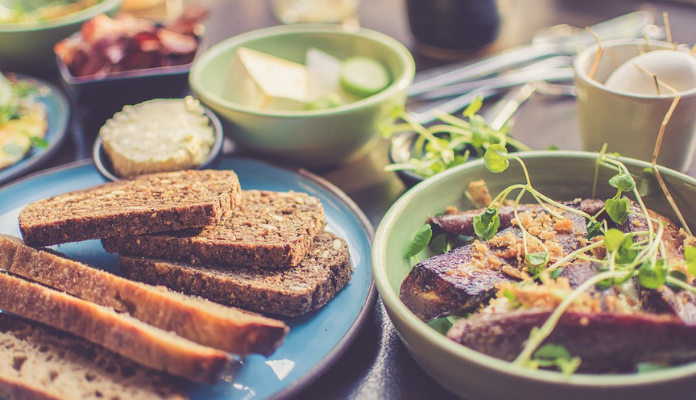Breads and Nutrition
The first bread was produced using a paste of grain flour and water. What we have today on our platter is a plethora of breads that range from simple flatbreads (Indian chapattis and Mexican tortillas) to leavened delights (like French baguettes, American bagels and Italian pizzas) and exquisite hand crafted artisan breads such as ciabatta, sour dough and focaccia breads. With so many types of breads available, choosing the best and the healthiest option can be confusing. So, here we highlight the most popular breads and their respective nutritive values.
Historians may differ on how the first bread was prepared but they all agree that it was the evolution of bread and later the industrialization of bread-making that revolutionized the entire food industry. Over the centuries, bread witnessed a radical change ¡n the ingredients used and in the method and equipment used to prepare it.
How To Choose Your Bread
While bread shopping, remember the golden rule that the best breads are prepared with whole grains, are packed with nutrients and fibre and contain the least amount of chemical additives. The healthy sounding label daims like brown bread, multigrain breads or enriched breads may often be misleading.
It is imperative to check the first ingredient in the list of ingredients. If it says wheat flour’ or ‘bleached flour,’ it might not be so healthy. Steer dear of these breads and also from the ones that list partially hydrogenated fats, corn syrup or enriched flour higher in the ingredient list. Pick the bread that says whole wheat or 100 per cent whole grain, low GI, low sodium and organic or high fibre labels.
White Bread Vs Whole Wheat Bread
A kernel of wheat grain contains an outer nutrient rich bran layer, followed by ‘germ’ (that germinates to create a new plant) and the innermost ‘endosperm’ that works as a storehouse for carbohydrates and proteins. White breads are prepared by a milling process that involves removal of bran and germ and retains only the endosperm. Whole wheat or whole grain breads, on the other hand, retain the germ and endosperm and sometimes a part of the outer bran too, thus rendering a darker colour and a coarser texture.
Evidently, white breads are not only lighter in colour but also lighter in nutrient composition and fibre content. Whole wheat breads are nutritionally superior with higher fibre content (1.9 grams of fibre ¡n a whole wheat bread slice versus 0.8 grams in white breads) and generous amounts of B vitamins, folic acid, magnesium, zinc and vitamin E.
Other Different Types Of Breads
Bagels And Baguettes – Decadent coffee shop treats such as bagels, croissants and buns are rich in taste and unfortunately, in calories and fat content too. Lean and crisp crusted baguettes or French loaf qualify as healthy breads with 85 calories, 17 grams carbs, 2.8 grams protein and one gram fat in a small slice.
Chapattis – When prepared at home without added salt and oil, our good old wheat chapattis are one of the healthiest breads (approx. 60 calones per chapatti). These unleavened flat breads are fibre rich and also lower in sodium and fat content than sliced breads. Step up the fibre content by adding jowar, bajra or soya flour to wheat flour. Naans and parathas are prepared with maida and best reserved for special events only.
Tortillas – Corn tortillas made from maize flour fare better than wheat tortillas, prepared using finely ground refined flours. Corn tortillas are gluten free, low ¡n calones and fats and contain fair amounts of fibre, iron and vitamins.
Pizza – While the refined flour based pizza crusts are a strict no-no, you may go for whole wheat, buck wheat or quinoa flour based pizza crusts with healthy toppings like cottage cheese, lean meats and vegetables.
Pita Bread – These baked ‘pocket’ soft flat breads are part of the staple diet in the Middle Eastern and Mediterranean countries. A medium sized wheat pita bread contains 125 calories, 25 grams carbs, 4.5 grams proteins and less than one gram fat. Pita breads boast popularity due to the versatility of eating anything ‘in, on or with’ it, but when it comes to nutritive value, they are lower in fibre content and higher in sodium content than whole wheat breads. Still, whole wheat pita breads make for a healthier option than white breads and maida pizza crusts.
Artisan Breads – Artisan breads are not the typical mass produced, store bought breads. These breads are prepared in small batches using select ingredients and are usually leavened slowly without chemical additives. High in fibre content (if whole grains are used) and often flavoured with herbs, garlic, onion, cheese and even fruits, artisan breads are undoubtedly superior in terms of taste, texture and flavour. However, unless you are sure that they are prepared using whole grains ilke millets, bran or whole wheat, they might not scale higher than sliced whole wheat breads nutritionally.
